Python内存管理机制-《源码解析》
Python内存管理机制
Python 内存管理分层架构
/* An object allocator for Python.
Here is an introduction to the layers of the Python memory architecture,
showing where the object allocator is actually used (layer +2), It is
called for every object allocation and deallocation (PyObject_New/Del),
unless the object-specific allocators implement a proprietary allocation
scheme (ex.: ints use a simple free list). This is also the place where
the cyclic garbage collector operates selectively on container objects.
Object-specific allocators
_____ ______ ______ ________
[ int ] [ dict ] [ list ] ... [ string ] Python core |
+3 | <----- Object-specific memory -----> | <-- Non-object memory --> |
_______________________________ | |
[ Python's object allocator ] | |
+2 | ####### Object memory ####### | <------ Internal buffers ------> |
______________________________________________________________ |
[ Python's raw memory allocator (PyMem_ API) ] |
+1 | <----- Python memory (under PyMem manager's control) ------> | |
__________________________________________________________________
[ Underlying general-purpose allocator (ex: C library malloc) ]
0 | <------ Virtual memory allocated for the python process -------> |
=========================================================================
_______________________________________________________________________
[ OS-specific Virtual Memory Manager (VMM) ]
-1 | <--- Kernel dynamic storage allocation & management (page-based) ---> |
__________________________________ __________________________________
[ ] [ ]
-2 | <-- Physical memory: ROM/RAM --> | | <-- Secondary storage (swap) --> |
*/
reference:Objects/obmalloc.c
layer 3: Object-specific memory(int/dict/list/string....)
python 实现并维护
用户对Python对象的直接操作,主要是各类特定对象的缓冲池机制,缓冲池,比如小整数对象池等等
layer 2: Python's object allocator
实现了创建/销毁python对象的接口(PyObject_New/Del),涉及对象参数/引用计数等
layer 1: Python's raw memory allocator (PyMem_ API)
包装了第0层的内存管理接口,提供同一个raw memory管理接口
封装的原因:不同操作系统C行为不一致,保证可移植性,相同语义相同行为
layer 0: Underlying general-purpose allocator (ex: C library malloc)
操作系统提供的内存管理接口,由操作系统实现并管理,Python不能干涉这一层的行为,大内存 分配调用malloc函数分配内存
Python 内存分配策略之-block,pool
Python中有分为大内存和小内存,512K为分界线
大内存使用系统malloc进行分配
小内存使用python内存池进行分配
1. 如果要分配的内存空间大于 SMALL_REQUEST_THRESHOLD bytes(512 bytes), 将直接使用layer 1的内存分配接口进行分配
2. 否则, 使用不同的block来满足分配需求
申请一块大小28字节的内存, 实际从内存中划到32字节的一个block (从size class index为3的pool里面划出)
block
内存块block 是python内存的最小单位
* For small requests we have the following table:
*
* Request in bytes Size of allocated block Size class idx
* ----------------------------------------------------------------
* 1-8 8 0
* 9-16 16 1
* 17-24 24 2
* 25-32 32 3
* 33-40 40 4
* 41-48 48 5
* 49-56 56 6
* 57-64 64 7
* 65-72 72 8
* ... ... ...
* 497-504 504 62
* 505-512 512 63
*
* 0, SMALL_REQUEST_THRESHOLD + 1 and up: routed to the underlying
* allocator.
*/
pool
pool内存池,管理block, 一个pool管理着一堆固定大小的内存块,在Python中, 一个pool的大小通常为一个系统内存页. 4kB
#define SYSTEM_PAGE_SIZE (4 * 1024)
#define SYSTEM_PAGE_SIZE_MASK (SYSTEM_PAGE_SIZE - 1)
#define POOL_SIZE SYSTEM_PAGE_SIZE /* must be 2^N */
#define POOL_SIZE_MASK SYSTEM_PAGE_SIZE_MASK
pool的4kB内存 = pool_header + block集合(N多大小一样的block)
typedef uint8_t block;
/* Pool for small blocks. */
struct pool_header {
union { block *_padding;
uint count; } ref; /* number of allocated blocks */
block *freeblock; /* pool's free list head */
struct pool_header *nextpool; /* next pool of this size class */
struct pool_header *prevpool; /* previous pool "" */
uint arenaindex; /* index into arenas of base adr */
uint szidx; /* block size class index */
uint nextoffset; /* bytes to virgin block */
uint maxnextoffset; /* largest valid nextoffset */
};
pool_header 作用
与其他pool链接, 组成双向链表
2. 维护pool中可用的block, 单链表
3. 保存 szidx , 这个和该pool中block的大小有关系, (block size=8, szidx=0), (block size=16, szidx=1)...用于内存分配时匹配到拥有对应大小block的pool
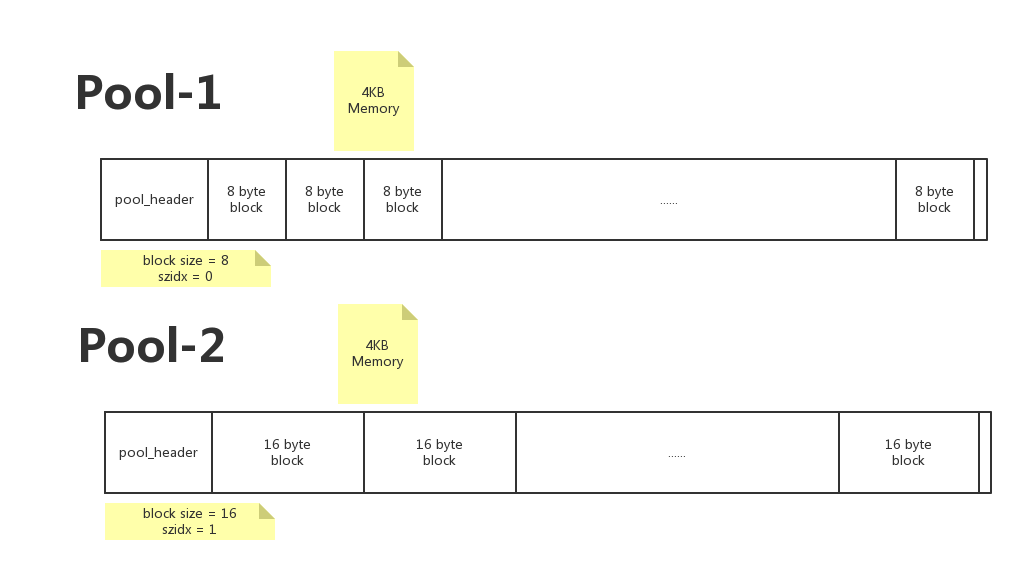
pool 初始化
void *
PyObject_Malloc(size_t nbytes)
{
...
init_pool:
// 1. 连接到 used_pools 双向链表, 作为表头
// 注意, 这里 usedpools[0] 保存着 block size = 8 的所有used_pools的表头
/* Frontlink to used pools. */
next = usedpools[size + size]; /* == prev */
pool->nextpool = next;
pool->prevpool = next;
next->nextpool = pool;
next->prevpool = pool;
pool->ref.count = 1;
// 如果已经初始化过了...这里看初始化, 跳过
if (pool->szidx == size) {
/* Luckily, this pool last contained blocks
* of the same size class, so its header
* and free list are already initialized.
*/
bp = pool->freeblock;
pool->freeblock = *(block **)bp;
UNLOCK();
return (void *)bp;
}
/*
* Initialize the pool header, set up the free list to
* contain just the second block, and return the first
* block.
*/
// 开始初始化pool_header
// 这里 size = (uint)(nbytes - 1) >> ALIGNMENT_SHIFT; 其实是Size class idx, 即szidx
pool->szidx = size;
// 计算获得每个block的size
size = INDEX2SIZE(size);
// 注意 #define POOL_OVERHEAD ROUNDUP(sizeof(struct pool_header))
// bp => 初始化为pool + pool_header size, 跳过pool_header的内存
bp = (block *)pool + POOL_OVERHEAD;
// 计算偏移量, 这里的偏移量是绝对值
// #define POOL_SIZE SYSTEM_PAGE_SIZE /* must be 2^N */
// POOL_SIZE = 4kb, POOL_OVERHEAD = pool_header size
// 下一个偏移位置: pool_header size + 2 * size
pool->nextoffset = POOL_OVERHEAD + (size << 1);
// 4kb - size
pool->maxnextoffset = POOL_SIZE - size;
// freeblock指向 bp + size = pool_header size + size
pool->freeblock = bp + size;
// 赋值NULL
*(block **)(pool->freeblock) = NULL;
UNLOCK();
return (void *)bp;
}

pool 进行block分配 - 总体代码
if (pool != pool->nextpool) { //
/*
* There is a used pool for this size class.
* Pick up the head block of its free list.
*/
++pool->ref.count;
bp = pool->freeblock; // 指针指向空闲block起始位置
assert(bp != NULL);
// 代码-1
// 调整 pool->freeblock (假设A节点)指向链表下一个, 即bp首字节指向的下一个节点(假设B节点) , 如果此时!= NULL
// 表示 A节点可用, 直接返回
if ((pool->freeblock = *(block **)bp) != NULL) {
UNLOCK();
return (void *)bp;
}
// 代码-2
/*
* Reached the end of the free list, try to extend it.
*/
// 有足够的空间, 分配一个, pool->freeblock 指向后移
if (pool->nextoffset <= pool->maxnextoffset) {
/* There is room for another block. */
// 变更位置信息
pool->freeblock = (block*)pool +
pool->nextoffset;
pool->nextoffset += INDEX2SIZE(size);
*(block **)(pool->freeblock) = NULL; // 注意, 指向NULL
UNLOCK();
// 返回bp
return (void *)bp;
}
// 代码-3
/* Pool is full, unlink from used pools. */ // 满了, 需要从下一个pool获取
next = pool->nextpool;
pool = pool->prevpool;
next->prevpool = pool;
pool->nextpool = next;
UNLOCK();
return (void *)bp;
}
pool进行block分配 -1
内存块尚未分配完, 且此时不存在回收的block, 全新进来的时候, 分配第一块block
(pool->freeblock = *(block **)bp) == NULL
当进入代码逻辑2时,表示有空闲的block, 代码2的执行流程图如下
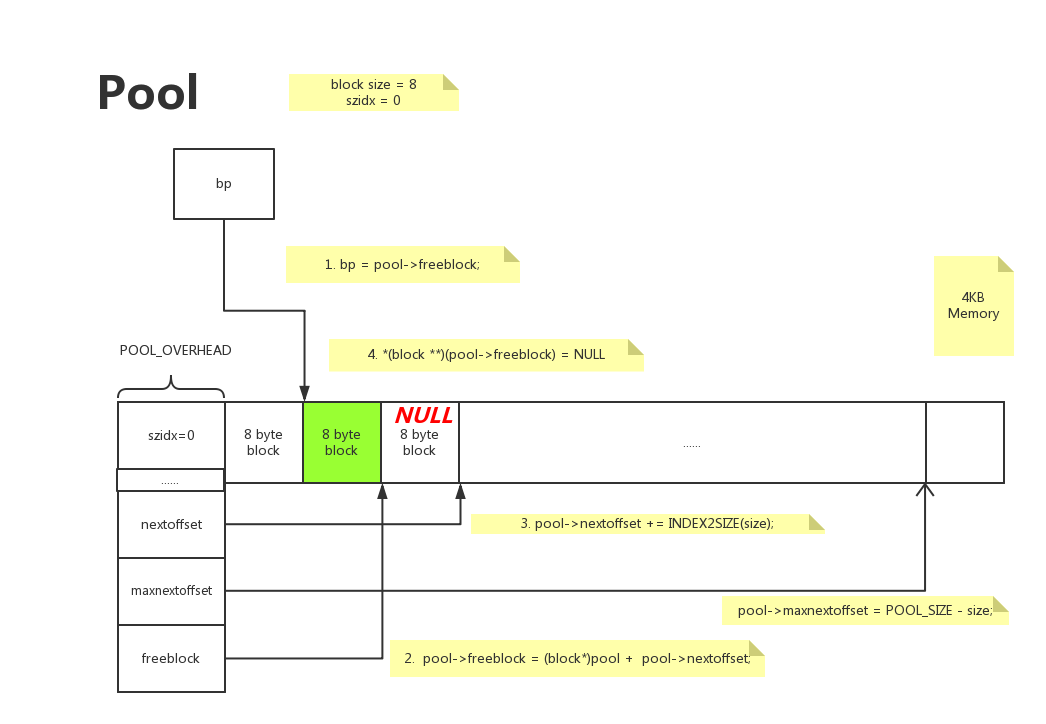
pool进行block分配 - 2 回收了某几个block
回收涉及的代码:
void
PyObject_Free(void *p)
{
poolp pool;
block *lastfree;
poolp next, prev;
uint size;
pool = POOL_ADDR(p);
if (Py_ADDRESS_IN_RANGE(p, pool)) {
/* We allocated this address. */
LOCK();
/* Link p to the start of the pool's freeblock list. Since
* the pool had at least the p block outstanding, the pool
* wasn't empty (so it's already in a usedpools[] list, or
* was full and is in no list -- it's not in the freeblocks
* list in any case).
*/
assert(pool->ref.count > 0); /* else it was empty */
// p被释放, p的第一个字节值被设置为当前freeblock的值
*(block **)p = lastfree = pool->freeblock;
// freeblock被更新为指向p的首地址
pool->freeblock = (block *)p;
// 相当于往list中头插入了一个节点
...
}
}
每释放一个block,该blcok就会变成pool->freeblock的头结点, 假设已经连续分配了5块, 第1块和第4块被释放,此时的内存图示如下:

此时再一个block分配调用进来, 执行分配, 进入的逻辑是代码-1
bp = pool->freeblock; // 指针指向空闲block起始位置
// 代码-1
// 调整 pool->freeblock (假设A节点)指向链表下一个, 即bp首字节指向的下一个节点(假设B节点) , 如果此时!= NULL
// 表示 A节点可用, 直接返回
if ((pool->freeblock = *(block **)bp) != NULL) {
UNLOCK();
return (void *)bp;
}
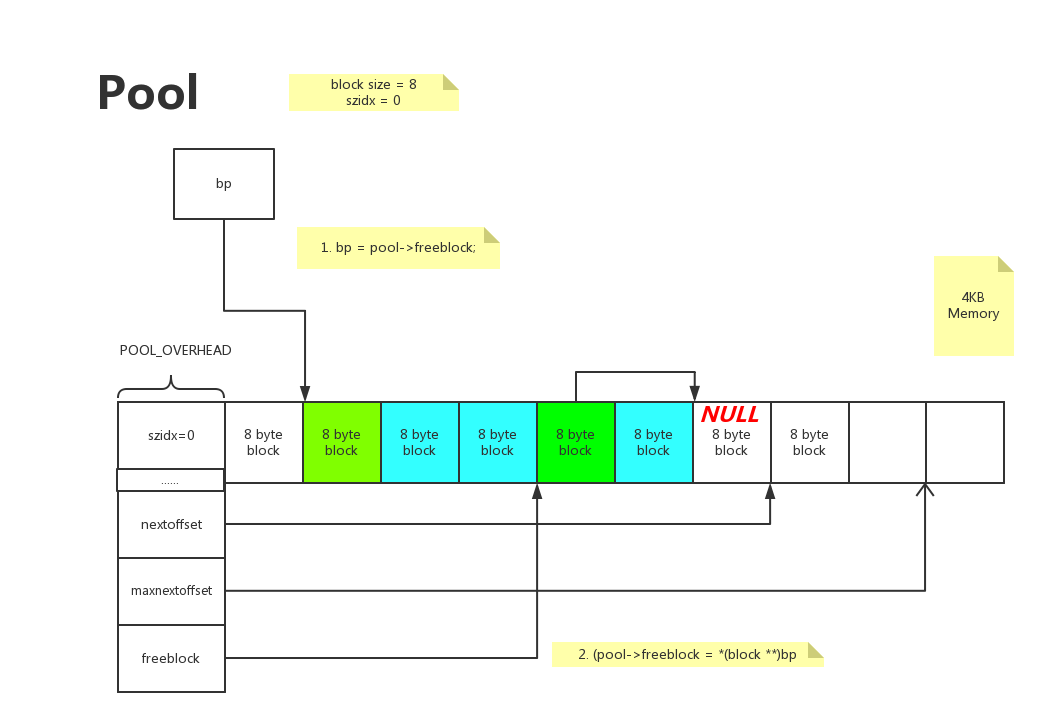
pool进行block分配 - 3 pool用完了
pool中内存空间都用完了, 进入代码-3
/* Pool is full, unlink from used pools. */ // 满了, 需要从下一个pool获取
next = pool->nextpool;
pool = pool->prevpool;
next->prevpool = pool;
pool->nextpool = next;
UNLOCK();
return (void *)bp;
Python 内存分配策略之-arena
arena: 多个pool聚合的结果, 可放置64个pool
#define ARENA_SIZE (256 << 10) /* 256KB */
arena结构
一个完整的arena = arena_object + pool集合
/* Record keeping for arenas. */
struct arena_object {
/* The address of the arena, as returned by malloc. Note that 0
* will never be returned by a successful malloc, and is used
* here to mark an arena_object that doesn't correspond to an
* allocated arena.
*/
uintptr_t address;
/* Pool-aligned pointer to the next pool to be carved off. */
block* pool_address;
/* The number of available pools in the arena: free pools + never-
* allocated pools.
*/
uint nfreepools;
/* The total number of pools in the arena, whether or not available. */
uint ntotalpools;
/* Singly-linked list of available pools. */
struct pool_header* freepools;
/* Whenever this arena_object is not associated with an allocated
* arena, the nextarena member is used to link all unassociated
* arena_objects in the singly-linked `unused_arena_objects` list.
* The prevarena member is unused in this case.
*
* When this arena_object is associated with an allocated arena
* with at least one available pool, both members are used in the
* doubly-linked `usable_arenas` list, which is maintained in
* increasing order of `nfreepools` values.
*
* Else this arena_object is associated with an allocated arena
* all of whose pools are in use. `nextarena` and `prevarena`
* are both meaningless in this case.
*/
struct arena_object* nextarena;
struct arena_object* prevarena;
};
arena_object的作用
1. 与其他arena连接, 组成双向链表
2. 维护arena中可用的pool, 单链表
- pool_header和管理的blocks内存是一块连续的内存 => pool_header被申请时,其管理的的block集合的内存一并被申请
uint maxnextoffset; /* largest valid nextoffset */ - arena_object 和其管理的内存是分离的 => arena_object被申请时,其管理的pool集合的内存没有被申请,而是在某一时刻建立关系的

arena的两种状态
/* The head of the singly-linked, NULL-terminated list of available
* arena_objects.
*/
// 单链表
static struct arena_object* unused_arena_objects = NULL;
/* The head of the doubly-linked, NULL-terminated at each end, list of
* arena_objects associated with arenas that have pools available.
*/
// 双向链表
static struct arena_object* usable_arenas = NULL;
arena 初始化
* Allocate a new arena. If we run out of memory, return NULL. Else
* allocate a new arena, and return the address of an arena_object
* describing the new arena. It's expected that the caller will set
* `usable_arenas` to the return value.
*/
static struct arena_object*
new_arena(void)
{
struct arena_object* arenaobj;
uint excess; /* number of bytes above pool alignment */
void *address;
static int debug_stats = -1;
if (debug_stats == -1) {
const char *opt = Py_GETENV("PYTHONMALLOCSTATS");
debug_stats = (opt != NULL && *opt != '\0');
}
if (debug_stats)
_PyObject_DebugMallocStats(stderr);
// 判断是否需要扩充"未使用"的arena_object列表
if (unused_arena_objects == NULL) {
uint i;
uint numarenas;
size_t nbytes;
/* Double the number of arena objects on each allocation.
* Note that it's possible for `numarenas` to overflow.
*/
// 确定需要申请的个数, 首次初始化, 16, 之后每次翻倍
numarenas = maxarenas ? maxarenas << 1 : INITIAL_ARENA_OBJECTS;
if (numarenas <= maxarenas)
return NULL; /* overflow */
#if SIZEOF_SIZE_T <= SIZEOF_INT
if (numarenas > SIZE_MAX / sizeof(*arenas))
return NULL; /* overflow */
#endif
nbytes = numarenas * sizeof(*arenas);
// 申请内存
arenaobj = (struct arena_object *)PyMem_RawRealloc(arenas, nbytes);
if (arenaobj == NULL)
return NULL;
arenas = arenaobj;
/* We might need to fix pointers that were copied. However,
* new_arena only gets called when all the pages in the
* previous arenas are full. Thus, there are *no* pointers
* into the old array. Thus, we don't have to worry about
* invalid pointers. Just to be sure, some asserts:
*/
assert(usable_arenas == NULL);
assert(unused_arena_objects == NULL);
/* Put the new arenas on the unused_arena_objects list. */
for (i = maxarenas; i < numarenas; ++i) {
arenas[i].address = 0; /* mark as unassociated */
// 新申请的一律为0, 标识着这个arena处于"未使用"
arenas[i].nextarena = i < numarenas - 1 ?
&arenas[i+1] : NULL;
}
// 将其放入unused_arena_objects链表中
// unused_arena_objects 为新分配内存空间的开头
/* Update globals. */
unused_arena_objects = &arenas[maxarenas];
maxarenas = numarenas;
}
/* Take the next available arena object off the head of the list. */
assert(unused_arena_objects != NULL);
// 从unused_arena_objects中, 获取一个未使用的object
arenaobj = unused_arena_objects;
unused_arena_objects = arenaobj->nextarena; // 更新链表
assert(arenaobj->address == 0);
// 申请内存, 256KB, 内存地址赋值给arena的address. 这块内存可用
address = _PyObject_Arena.alloc(_PyObject_Arena.ctx, ARENA_SIZE);
if (address == NULL) {
/* The allocation failed: return NULL after putting the
* arenaobj back.
*/
arenaobj->nextarena = unused_arena_objects;
unused_arena_objects = arenaobj;
return NULL;
}
arenaobj->address = (uintptr_t)address;
++narenas_currently_allocated;
++ntimes_arena_allocated;
if (narenas_currently_allocated > narenas_highwater)
narenas_highwater = narenas_currently_allocated;
arenaobj->freepools = NULL;
/* pool_address <- first pool-aligned address in the arena
nfreepools <- number of whole pools that fit after alignment */
arenaobj->pool_address = (block*)arenaobj->address;
arenaobj->nfreepools = MAX_POOLS_IN_ARENA;
// 将pool的起始地址调整为系统页的边界
// 申请到 256KB, 放弃了一些内存, 而将可使用的内存边界pool_address调整到了与系统页对齐
excess = (uint)(arenaobj->address & POOL_SIZE_MASK);
if (excess != 0) {
--arenaobj->nfreepools;
arenaobj->pool_address += POOL_SIZE - excess;
}
arenaobj->ntotalpools = arenaobj->nfreepools;
return arenaobj;
}
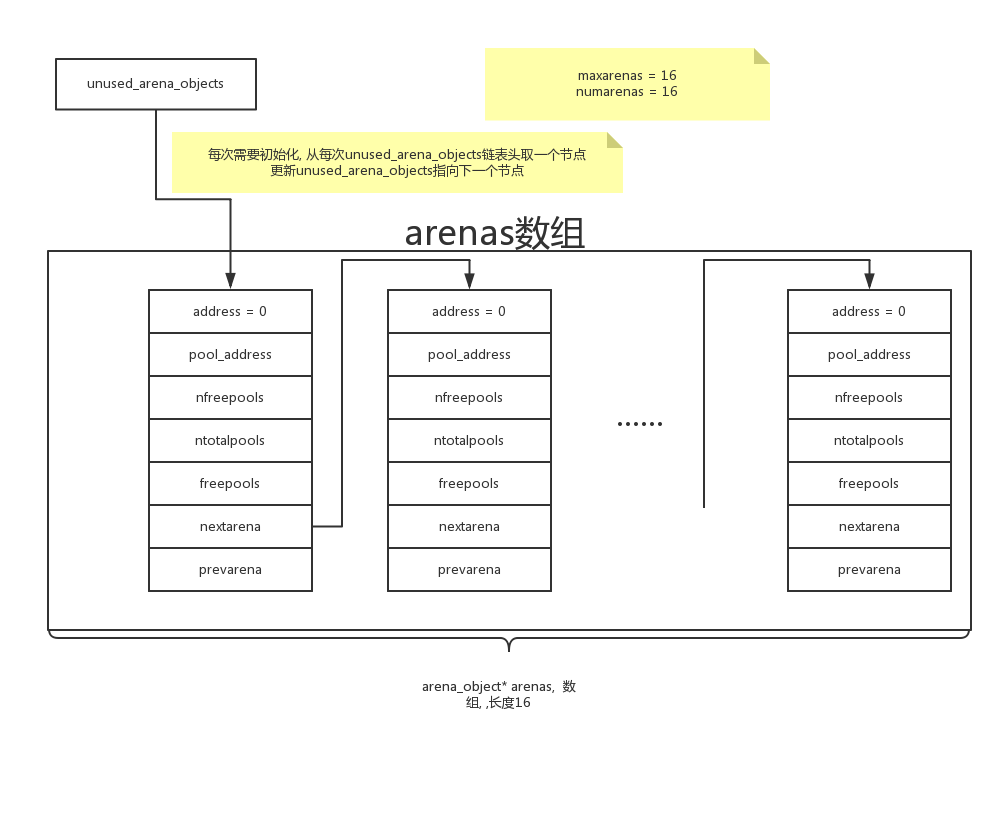
从arenas取一个arena进行初始化
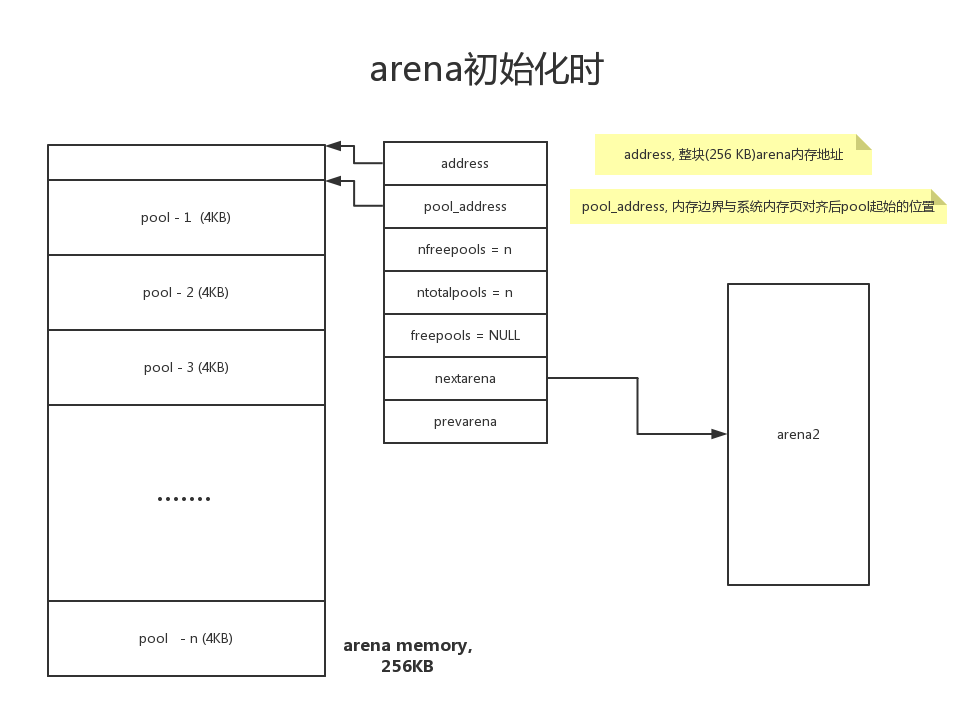
arena分配
new一个全新的arena
static void*
pymalloc_alloc(void *ctx, size_t nbytes)
{
// 刚开始没有可用的arena
if (usable_arenas == NULL) {
// new一个, 作为双向链表的表头
usable_arenas = new_arena();
if (usable_arenas == NULL) {
UNLOCK();
goto redirect;
}
usable_arenas->nextarena =
usable_arenas->prevarena = NULL;
}
.......
// 从arena中获取一个pool
pool = (poolp)usable_arenas->pool_address;
assert((block*)pool <= (block*)usable_arenas->address +
ARENA_SIZE - POOL_SIZE);
pool->arenaindex = usable_arenas - arenas;
assert(&arenas[pool->arenaindex] == usable_arenas);
pool->szidx = DUMMY_SIZE_IDX;
// 更新 pool_address 向下一个节点
usable_arenas->pool_address += POOL_SIZE;
// 可用节点数量-1
--usable_arenas->nfreepools;
}
从全新的arena中获取一个pool

假设arena是旧的, 怎么分配的pool, 跟pool分配block原理一样,使用单链表记录freepools
pool = usable_arenas->freepools;
if (pool != NULL) {
当arena中一整块pool被释放的时候
/* Free a memory block allocated by pymalloc_alloc().
Return 1 if it was freed.
Return 0 if the block was not allocated by pymalloc_alloc(). */
static int
pymalloc_free(void *ctx, void *p) {
struct arena_object* ao;
uint nf; /* ao->nfreepools */
/* Link the pool to freepools. This is a singly-linked
* list, and pool->prevpool isn't used there.
*/
ao = &arenas[pool->arenaindex];
pool->nextpool = ao->freepools;
ao->freepools = pool;
nf = ++ao->nfreepools;
}
在pool整块被释放的时候, 会将pool加入到arena->freepools作为单链表的表头, 然后, 在从非全新arena中分配pool时, 优先从arena->freepools里面取, 如果取不到, 再从arena内存块里面获取

注: 上图中nfreepools = n - 2
当arena1用完了,获取arena1指向的下一个节点arena2
static void*
pymalloc_alloc(void *ctx, size_t nbytes)
{
// 当发现用完了最后一个pool!!!!!!!!!!!
// nfreepools = 0
if (usable_arenas->nfreepools == 0) {
assert(usable_arenas->nextarena == NULL ||
usable_arenas->nextarena->prevarena ==
usable_arenas);
/* Unlink the arena: it is completely allocated. */
// 找到下一个节点!
usable_arenas = usable_arenas->nextarena;
// 右下一个
if (usable_arenas != NULL) {
usable_arenas->prevarena = NULL; // 更新下一个节点的prevarens
assert(usable_arenas->address != 0);
}
// 没有下一个, 此时 usable_arenas = NULL, 下次进行内存分配的时候, 就会从arenas数组中取一个
}
}
注意: 这里有个逻辑, 就是每分配一个pool, 就检查是不是用到了最后一个, 如果是, 需要变更usable_arenas到下一个可用的节点, 如果没有可用的, 那么下次进行内存分配的时候, 会判定从arenas数组中取一个
arena回收
内存分配和回收最小单位是block, 当一个block被回收的时候, 可能触发pool被回收, pool被回收, 将会触发arena的回收机制
- arena中所有pool都是闲置的(empty), 将arena内存释放, 返回给操作系统
- 如果arena中之前所有的pool都是占用的(used), 现在释放了一个pool(empty), 需要将 arena加入到usable_arenas, 会加入链表表头
- 如果arena中empty的pool个数n, 则从useable_arenas开始寻找可以插入的位置. 将arena插入. (useable_arenas是一个有序链表, 按empty pool的个数, 保证empty pool数量越多, 被使用的几率越小, 最终被整体释放的机会越大)
内存分配的步骤
关注点:如何寻找到一块可用的nbytes的blcok内存?
pool = usedpools[size + size]
if pool:
pool 没满,取一个blcok返回
pool 满了,从下一个pool取一个blcok返回
else:
获取arena, 从里面初始化一个pool, 拿到第一个blcok返回
进行内存分配和销毁, 所有操作都是在pool上进行的
问题: pool中所有block的size一样, 但是在arena中, 每个pool的size都可能不一样, 那么最终这些pool是怎么维护的? 怎么根据大小找到需要的block所在的pool? =>
usedpools
pool在内存池中的三种状态
- used状态:pool中至少有一个block已经被使用,并且至少有一个block未被使用,这种状态的pool受控于Python内部维护的usedpool数组
- full状态:pool中所有的block都已经被使用,这种状态的pool在arena中, 但不在arena的freepools链表中,处于full的pool各自独立, 不会被链表维护起来
- empty状态:pool中所有的blcok都未被使用,处于这个状态的pool的集合通过其pool_header中的nextpool构成一个链表,链表的表头示arena_object中的freepools

Python内部维护的usedpools数组是一个非常巧妙的实现,维护着所有的处于used状态的pool,当申请内存时,python就会通过usedpools寻找到一个可用的pool(处于used状态),从中分配一个block。因此我们想,一定有一个usedpools相关联的机制,完成从申请的内存的大小到size class index之间的转换,否则python就无法找到最合适的pool了。这种机制和usedpools的结构有着密切的关系,我们看一下它的结构
usedpools
usedpools数组: 维护着所有处于used状态的pool, 当申请内存的时候, 会通过usedpools寻找到一块可用的(处于used状态的)pool, 从中分配一个block。
//obmalloc.c
typedef uint8_t block;
#define PTA(x) ((poolp )((uint8_t *)&(usedpools[2*(x)]) - 2*sizeof(block *)))
#define PT(x) PTA(x), PTA(x)
//在我当前的机器就是512/8=64个,对应的size class index就是从0到63
#define NB_SMALL_SIZE_CLASSES (SMALL_REQUEST_THRESHOLD / ALIGNMENT)
static poolp usedpools[2 * ((NB_SMALL_SIZE_CLASSES + 7) / 8) * 8] = {
PT(0), PT(1), PT(2), PT(3), PT(4), PT(5), PT(6), PT(7)
#if NB_SMALL_SIZE_CLASSES > 8
, PT(8), PT(9), PT(10), PT(11), PT(12), PT(13), PT(14), PT(15)
#if NB_SMALL_SIZE_CLASSES > 16
, PT(16), PT(17), PT(18), PT(19), PT(20), PT(21), PT(22), PT(23)
#if NB_SMALL_SIZE_CLASSES > 24
, PT(24), PT(25), PT(26), PT(27), PT(28), PT(29), PT(30), PT(31)
#if NB_SMALL_SIZE_CLASSES > 32
, PT(32), PT(33), PT(34), PT(35), PT(36), PT(37), PT(38), PT(39)
#if NB_SMALL_SIZE_CLASSES > 40
, PT(40), PT(41), PT(42), PT(43), PT(44), PT(45), PT(46), PT(47)
#if NB_SMALL_SIZE_CLASSES > 48
, PT(48), PT(49), PT(50), PT(51), PT(52), PT(53), PT(54), PT(55)
#if NB_SMALL_SIZE_CLASSES > 56
, PT(56), PT(57), PT(58), PT(59), PT(60), PT(61), PT(62), PT(63)
#if NB_SMALL_SIZE_CLASSES > 64
#error "NB_SMALL_SIZE_CLASSES should be less than 64"
#endif /* NB_SMALL_SIZE_CLASSES > 64 */
#endif /* NB_SMALL_SIZE_CLASSES > 56 */
#endif /* NB_SMALL_SIZE_CLASSES > 48 */
#endif /* NB_SMALL_SIZE_CLASSES > 40 */
#endif /* NB_SMALL_SIZE_CLASSES > 32 */
#endif /* NB_SMALL_SIZE_CLASSES > 24 */
#endif /* NB_SMALL_SIZE_CLASSES > 16 */
#endif /* NB_SMALL_SIZE_CLASSES > 8 */
};
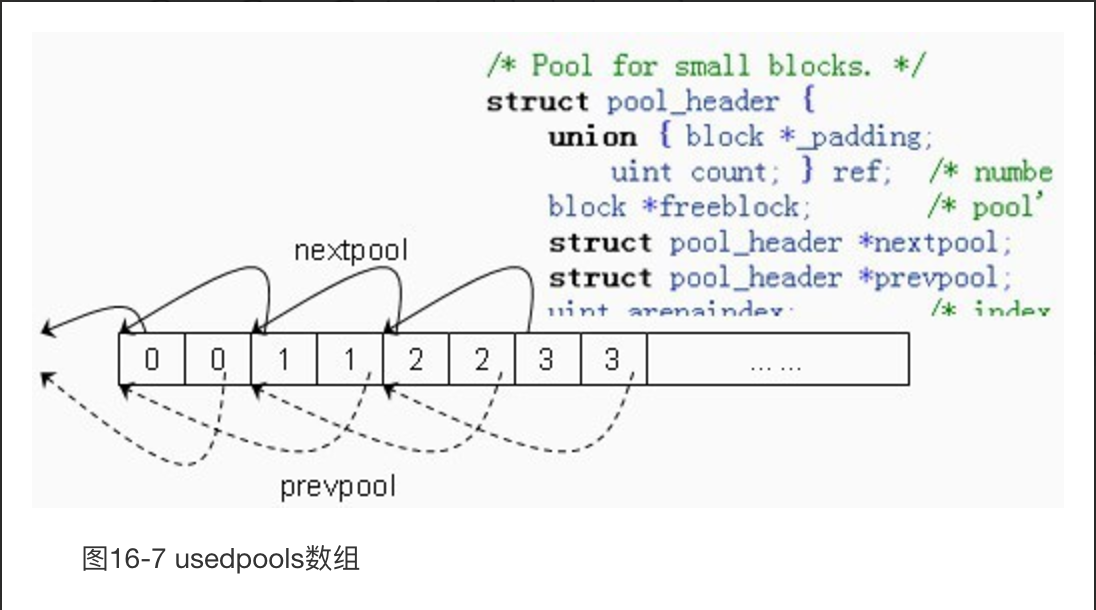
如果正在申请28字节, python首先会获取(size class index) size = (uint )(nbytes - 1) >> ALIGNMENT_SHIFT 显然这里size=3, 那么在usedpools中,寻找第3+3=6个元素,发现usedpools[6]的值是指向usedpools[4]的地址
//obmalloc.c
/* Pool for small blocks. */
struct pool_header {
union { block *_padding;
uint count; } ref; /* 当然pool里面的block数量 */
block *freeblock; /* 一个链表,指向下一个可用的block */
struct pool_header *nextpool; /* 指向下一个pool */
struct pool_header *prevpool; /* 指向上一个pool "" */
uint arenaindex; /* 在area里面的索引 */
uint szidx; /* block的大小(固定值?后面说) */
uint nextoffset; /* 下一个可用block的内存偏移量 */
uint maxnextoffset; /* 最后一个block距离开始位置的距离 */
};
显然是从usedpools[6]
(即usedpools+4)开始向后偏移8个字节(一个ref的大小加上一个freeblock的大小)后的内存,正好是usedpools[6]的地址(即usedpools+6),这是python内部的trick
当我们要申请一个size class为32字节的pool,想要将其放入这个usedpools中时,要怎么做呢?从上面的描述我们知道,只需要进行usedpools[i+i] -> nextpool = pool即可,其中i为size class index,对应于32字节,这个i为3.当下次需要访问size class 为32字节(size class index为3)的pool时,只需要简单地访问usedpools[3+3]就可以得到了。python正是使用这个usedpools快速地从众多的pool中快速地寻找到一个最适合当前内存需求的pool,从中分配一块block。
//obmalloc.c
static int
pymalloc_alloc(void *ctx, void **ptr_p, size_t nbytes)
{
block *bp;
poolp pool;
poolp next;
uint size;
...
LOCK();
//获得size class index
size = (uint)(nbytes - 1) >> ALIGNMENT_SHIFT;
//直接通过usedpools[size+size],这里的size不就是我们上面说的i吗?
pool = usedpools[size + size];
//如果usedpools中有可用的pool
if (pool != pool->nextpool) {
... //有可用pool
}
... //无可用pool,尝试获取empty状态的pool
}
内存池全局结构
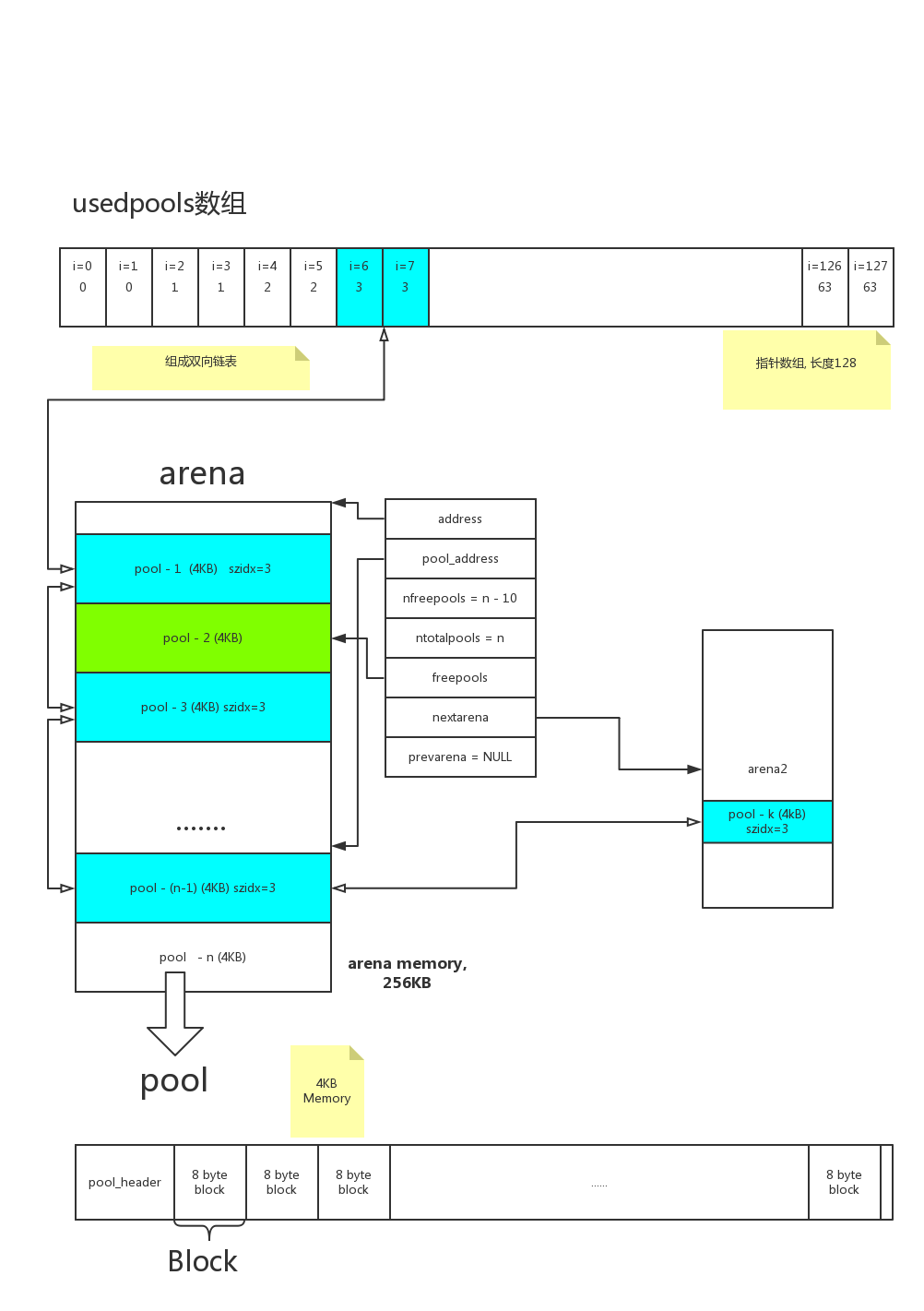
python中万物皆对象,他的核心结构是:PyObject
typedef __int64 ssize_t;
typedef ssize_t Py_ssize_t;
typedef struct _object {
_PyObject_HEAD_EXTRA
Py_ssize_t ob_refcnt; // Py_ssize_t __int64
struct _typeobject *ob_type;
} PyObject;
typedef struct {
PyObject ob_base;
Py_ssize_t ob_size; /* Number of items in variable part */
} PyVarObject;
PyObject是每个对象的底层数据结构,其中ob_refcnt就是作为引用计数。当一个对象有新的引用时, 它的ob_refcnt就会增加,当引用它的对象被删除,它的ob_refcnt就会减少,当引用技术为0时,该对象的生命结束了。
- 引用计数+1的情况
- 对象被创建 eg: a=2
- 对象被引用 eg: b=a
- 对象被作为参数,传入到一个函数中,例如func(a)
- 对象作为一个元素,存储在容器中,例如list1=[a, b]
- 引用计数-1的情况
- 对象的别名被显示的销毁 eg: del a
- 对象的别名被赋予新的对象 eg: a=34
- 一个对象离开它的作用域, 例如f函数执行完毕时,func函数中的局部变量(全局变量不会)
- 对象所在的容器被销毁,或者从容器中删除
如何查看对象的引用计数
import sys
a = 'hello'
sys.getrefcount(a)
// 注意: getrefcount(a) 传入a时, a的引用计数会加1
1. 小整数对象池
#ifndef NSMALLPOSINTS
#define NSMALLPOSINTS 257
#endif
#ifndef NSMALLNEGINTS
#define NSMALLNEGINTS 5
#endif
#if NSMALLNEGINTS + NSMALLPOSINTS > 0
/* Small integers are preallocated in this array so that they
can be shared.
The integers that are preallocated are those in the range
-NSMALLNEGINTS (inclusive) to NSMALLPOSINTS (not inclusive).
*/
static PyLongObject small_ints[NSMALLNEGINTS + NSMALLPOSINTS];
Py_INCREF(op) 增加对象引用计数
Py_DECREF(op) 减少对象引用计数, 如果计数位0, 调用_Py_Dealloc
_Py_Dealloc(op) 调用对应类型的 tp_dealloc 方法
小整数对象池就是一个PyLongObject 数组, 大小=257+5=262, 范围是[-5, 257) 注意左闭右开.
python对小整数的定义是[-5, 257), 这些整数对象是提前建立好的,不会被垃圾回收,在一个python程序中,所有位于这个范围内的整数使用的都是同一个对象
小整数[-5, 257)共用对象,常驻内存
单个字母共用对象,常驻内存
单个单词,不可修改,默认开启intern机制,共用对象,引用计数为0时,销毁
Python内存管理机制-《源码解析》的更多相关文章
- Python内存管理机制及优化简析(转载)
from:http://kkpattern.github.io/2015/06/20/python-memory-optimization-zh.html 准备工作 为了方便解释Python的内存管理 ...
- 【python测试开发栈】—python内存管理机制(二)—垃圾回收
在上一篇文章中(python 内存管理机制-引用计数)中,我们介绍了python内存管理机制中的引用计数,python正是通过它来有效的管理内存.今天来介绍python的垃圾回收,其主要策略是引用计数 ...
- 史上最详细的Android消息机制源码解析
本人只是Android菜鸡一个,写技术文章只是为了总结自己最近学习到的知识,从来不敢为人师,如果里面有不正确的地方请大家尽情指出,谢谢! 606页Android最新面试题含答案,有兴趣可以点击获取. ...
- 解读Python内存管理机制
转自:http://developer.51cto.com/art/201007/213585.htm 内存管理,对于Python这样的动态语言,是至关重要的一部分,它在很大程度上甚至决定了Pytho ...
- 了解Python内存管理机制,让你的程序飞起来
引用: 语言的内存管理是语言设计的一个重要方面.它是决定语言性能的重要因素.无论是C语言的手工管理,还是Java的垃圾回收,都成为语言最重要的特征.这里以Python语言为例子,说明一门动态类型的.面 ...
- Android Handler消息机制源码解析
好记性不如烂笔头,今天来分析一下Handler的源码实现 Handler机制是Android系统的基础,是多线程之间切换的基础.下面我们分析一下Handler的源码实现. Handler消息机制有4个 ...
- 【python测试开发栈】python内存管理机制(一)—引用计数
什么是内存 在开始进入正题之前,我们先来回忆下,计算机基础原理的知识,为什么需要内存.我们都知道计算机的CPU相当于人类的大脑,其运算速度非常的快,而我们平时写的数据,比如:文档.代码等都是存储在磁盘 ...
- Python深入之python内存管理机制(重点)
前言 本文的文字及图片来源于网络,仅供学习.交流使用,不具有任何商业用途,版权归原作者所有,如有问题请及时联系我们以作处理. 作者:醍醐三叶 关于python的存储问题, (1)由于python中 ...
- (重点)Python深入之Python内存管理机制你会吗?
前言本文的文字及图片来源于网络,仅供学习.交流使用,不具有任何商业用途,版权归原作者所有,如有问题请及时联系我们以作处理.作者:醍醐三叶 请注意:如果你平时学Python遇到问题找不到人解答?或者没有 ...
随机推荐
- 【Leetcode】164. Maximum Gap 【基数排序】
Given an unsorted array, find the maximum difference between the successive elements in its sorted f ...
- Django组件content-type使用方法详解
前言 参考博客:https://www.zhangshengrong.com/p/zD1yQJwp1r/ 一个表和多个表进行关联,但具体随着业务的加深,表不断的增加,关联的数量不断的增加,怎么通过一开 ...
- C# 操作Orcle数据库
1.首先添加NuGet:Oracle.ManagedDataAccess 2.配置连接数据库字符串:Data Source=(DESCRIPTION=(ADDRESS=(PROTOCOL=TCP)(H ...
- drf 生命周期
1) 根据应用中urls.py,走as_view方法,但是视图类没有该方法,所以请求走的是APIView的as_view方法 2) 在APIView的as_view调用父类(django原生View) ...
- GreenPlum-数据存储目录迁移及常用操作
一.环境介绍 Greenplum5 3节点集群,Centos7.2虚拟机, 二.需求 因为/home目录磁盘空间已满,需要将Greenplum的数据存储目录转移到新的分区/opt目录下,虚拟机磁盘管理 ...
- C# 数据操作系列 - 12 NHibernate的增删改查
0. 前言 上一篇<C# 数据操作系列 - 11 NHibernate 配置和结构介绍> 介绍了Nhibernate里的配置内容.这一篇将带领大家了解一下如何使用NHIbernate.之前 ...
- CF916C
题目链接:http://codeforces.com/contest/916/problem/C 题目大意: 用\(n\)个结点,\(m\)条边(每条边的权值范围为[1, 109]) 构造出一个无向带 ...
- 自己写的vue底导航
<template> <div id="app"> <div class="tabbar"> <div class=& ...
- 剑指Offer之矩形覆盖
题目描述 我们可以用2*1的小矩形横着或者竖着去覆盖更大的矩形.请问用n个2*1的小矩形无重叠地覆盖一个2*n的大矩形,总共有多少种方法? 比如n=3时,2*3的矩形块有3种覆盖方法: 思路:与裴波拉 ...
- MySQL 5.7.30 的安装/升级(所有可能的坑都在这里)
楔子 由于之前电脑上安装的MySQL版本是比较老的了,大概是5.1的版本,不支持JSON字段功能.而最新开发部门开发的的编辑器产品,使用到了JSON字段的功能. 因此需要升级MySQL版本,升级的目标 ...
